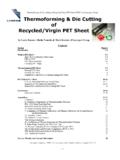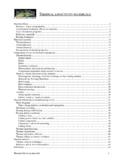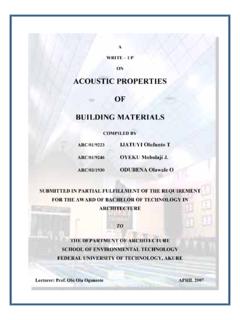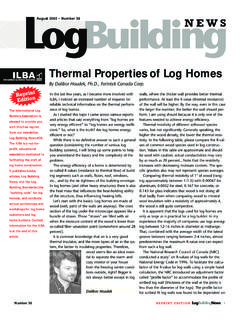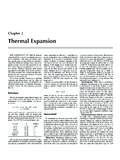Transcription of Thermal and Mechanical Properties of Recycled PET and its ...
1 Thermal and Mechanical Properties of Recycled PET and its blends Parthasarathy Pattabiraman, Dr. Igor Sbarski, Prof Tom Spurling, IRIS, Swinburne University of Technology, Melbourne, Australia Adj. Prof Edward Kosior, Visy Industries, Melbourne, Australia Abstract PET is known to be a hygroscopic This paper discusses the Thermal and thermplastic material absorbing Mechanical Properties of virgin PET moisture easily. Thus optimum drying , Recycled PET and their blends. condition is very crucial prior to Differential scanning calorimetry processing. Moisture content in (DSC) and thermogravimetric analysis polymer promotes degradation while (TGA) were used to study the Thermal processing leading to a breakdown of Properties . The tensile tests at ambient molecular weight which in turn affects and elevated temperature were used to final product Properties . study the Mechanical Properties . There were significant differences in the Experimental recrystallization behaviour as far as the Materials: Thermal Properties were concerned.
2 In Granules of three different grades of the case of Mechanical Properties , the PET were supplied by Leading tensile test at elevated temperature Synthetics Pty: showed that the strength of the blends i) 100% virgin PET (BK3180). of Recycled PET/virgin PET were ii) 100% Recycled food grade PET. lower than those ones of virgin PET. iii) 100% Recycled fibre grade PET. Procedures: Introduction Blends of virgin PET and Recycled Polyethylene terephthalate(PET) is a food grade PET were prepared in the condensation polyester produced by following weight ratios. the reaction of di-acid and di-alcohol. i) 90% virgin PET 10%. The major raw materials for the Recycled PET. production of PET are dimethyl ii) 80% virgin PET 20%. terephthalate (DMT), terephthalicacid Recycled PET. (TPA) and ethylene glycol (EG). PET iii) 70% virgin PET 30%. is a major polymer with diverse Recycled PET. applications. The semicrystalline iv) 50% virgin PET 50%.
3 Nature of this polyester allows one to Recycled PET. generate a wide variety of both All the different grades of PET were physical and Mechanical Properties dried in a vacuum oven at a well suited for the fabrication of fibers, temperature of 170 C for four hours. films, bottles and different molded The dried materials were sealed in an parts. These parts are converted into aluminium foil bag in order to prevent finished products such as garments, its exposure to the atmosphere. carpets, packages and industrial goods. Samples for Mechanical tests were Most of the physical and Mechanical produced using Battenfeld BA 350/75. Properties of PET improve as the Plus injection moulding machine with molecular weight increases. The the following settings: molecular weight required is dictated Barrel temperature: by the end use of the polyester. So the Reverse zone: 25 C. PET resins (especially food grade) Mid zone: 290 C. undergo solid state polycondensation Front zone: 285 C.
4 In order to lift up its molecular weight. Nozzle: 285 C. ANTEC 2005 / 3221. Cooling time: 13 sec degree of crystallinity is hardly Mould temperature: 10-15 C affected by the content of Recycled The Differential scanning calorimeter PET. However, significant differences (DSC) tests were run in a nitrogen were seen in the recrystallisation atmosphere with a 10 C/min temperatures of different materials. heating/cooling ramp from room Fig 1 shows that the recrystallisation temperature to 290 C using a sample temperature is entirely dependent on mass between 6-12mg. The TGA tests the Recycled content. The higher the were run at a temperature ramp of Recycled content in the PET material 10 C/min from room temperature to the higher the temperature at which the 500 C. TGA was done to note the material starts to recrystallize. The differences in the degradation recrystallisation temperature for the behaviour of the materials. In the case virgin PET is the lowest while both the of the DSC, 2-cycle tests were run.
5 Recycled food grade and the Recycled The first cycle erases the Thermal fibre grade showing values way ahead history of the sample, heating it above of the virgin one. The Recycled food the melting temperature, so that the grade PET shows much higher data from the second cycle is not recrystallisation temperature than the influenced by undefined process virgin PET though the degree of related cooling. Tensile tests were crystallinity for both of them differ carried out initially at ambient merely by (Table1). The conditions and then at elevated Recycled fibre grade PET has the temperature for all materials. At highest melting temperature as well as ambient conditions, the test was run in the highest level of crystallinity when a Zwick Z010 universal testing compared to other grades. The TGA. machine as per the Australian Standard tests didn't reveal any sort of AS The tensile test at differences in the degradation elevated temperature was performed on behaviour of the materials.
6 Virgin an INSTRON tensile tester using a PET starts to degrade slowly around Thermal chamber surrounding the 380 C before the weight starts to clamp set-up and the tensile sample decrease significantly at 400 C. For and the temperature employed was all the materials tested the plot of TGA. 110 C. These conditions were chosen looks the same. There is no difference to compare the stretching behaviour of between the virgin and the Recycled various materials. The maximum materials. None of the materials possible test speed the clamps could showed a significant weight loss until hold without the samples being slipped 380 C. was about 200 mm/min. The tensile In the case of Mechanical Properties , bars were given 5 minutes in the the tensile test at ambient conditions Thermal chamber to achieve showed that the virgin PET had tensile equilibrium temperature before the test strength almost similar to those of the was started. Here again five samples 90-10, 80-20, 70-30 and 50-50 blends.
7 Were tested to obtain one set of result They had a value approximately equal for each material. to 57 MPa while the rest of the two 100% Recycled PET showed a tensile Results and Discussion strength of 66 MPa. This was due to Table 1 shows the variations of higher crystallinity of the Recycled melting temperature and the PETs as compared to the other crystallinity with the Recycled PET materials. Fig 2 indicates that the content. The results indicate that the modulus of elasticity for the virgin 3222 / ANTEC 2005. PET and Recycled PET (food and fibre (1). John Scheirs, Compositional and grade) are fairly similar when Failure Analysis of Polymers-A. compared to their blends. In the tensile Practical Approach , John Wiley &. test done at elevated temperature, as Sons,England,107-128, (2000). the test temperature was above the glass transition temperature of PET, (2). , , the tensile bars went into a rubbery and , Methods for the state which explains why the tensile Measurement of Crystallinity of strength of the materials is much lower preforms and bottles made from PET , than at ambient temperature.
8 Fig 3 SPE ANTEC Proceedings,1,816-20. shows that at elevated temperatures the (1998). tensile strength and modulus of elasticity of Recycled grade PETs are (3). Mantia & Michele lower than that of the virgin PET Vinci, Recycling Poly(ethylene while at ambient temperature the trend terephthalate) ,Polymer Degradation is quite opposite. and Stability,45,121-125 (1994). Conclusions (4).Sandro Donnini Mancini,Maria The recrystallisation temperature is Zanin, Recyclability of Pet from directly influenced by the Recycled Virgin Resin , Materials Research, PET content. Addition of more 2, , 33-38, (1999). Recycled content in virgin PET. increases the recrystallisation (5). Scott Kennedy, Effects of Drying temperature significantly with 100% parameters on Recycled PET , SPE. Recycled PET showing the maximum ANTEC Proceedings 3,3707-3710, value. At elevated temperature,the (1999). tensile strength and modulus of elasticity of virgin PET are higher than (6).
9 John Scheirs, Polymer Recycling: the Recycled PET and their blends. This science,technology and applications , showed that the Mechanical Properties John Wiley & Sons, New York,153- of the blends of virgin/ Recycled PET 180,(1998). are worse than those of the virgin ones. (7). , , Keywords and , The Calorimetric and Virgin PET, Recycled PET, Mechanical Properties of Virgin and Mechanical Properties , Thermal Recycled Poly(Ethylene Terephthalate). Properties . from beverage bottles ,Polymer Engineering and Science,27,11,796- 802,(1987). References ANTEC 2005 / 3223. Melting temperature, C. Recycled content of PET in % Crystallinity in %. 100% virgin PET (BK3180) 90% virgin PET/10% RPET 80% virgin PET/20% RPET 70% virgin PET/30% RPET 50% virgin PET/50% RPET 100% RPET (food grade) 100% RPET (fibre grade) Table 1: Degree of crystallinity of PET blends Thermal Properties of PET blends recrystallisation temperature in C. 0 10 20 30 50 100 100 (fibre gr).
10 Recycled content PET in %. Figure 1: Recrystallisation temperature of PET blends. 3224 / ANTEC 2005. Mechanical Properties of PET blends 2450. 2400. 2350. Youngs modulus in MPa 2300. 2250 2200. 2150. 2100. 2050. 0 10 20 30 50 100% 100%. food fibre Recycled content PET in %. Figure 2: Young modulus of PET blends at ambient temperature tensile test at 110 C, 5 min equilibrium tensile strength in MPa E-Modulus in MPa stress at 500% strain in MPa strain at max stress in %. 5 100. 4 80. tensile strength in MPa 3 60. 2 40. 1 20. 0 0. 0 50 100. content PCR PET in %. Figure 3: Mechanical Properties of PET blends at 110 C. ANTEC 2005 / 3225.
